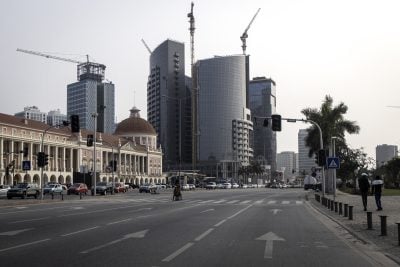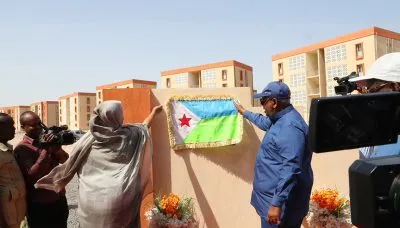In February 2018 Djibouti terminated its contract with Dubai’s DP World and set up a public company – Société de Gestion du Terminal à Conteneurs de Doraleh (SGTD) – to run Doraleh Container Port. The port is now expanding rapidly, as its CEO Abdillahi Adaweh Sigad tells African Business
What were your priorities when you took office as CEO of Doraleh Container Port in 2018?
Following the takeover of the terminal and of the company by the Djiboutian authorities, we thought it was important to start by carrying out a comprehensive audit in order to identify the measures to be implemented in the short term as well as the action plan for the medium term. The terminal has a solid base of local and regional customers. However, while benefiting from a very favorable geographical position, the terminal has been handling a low volume of international maritime traffic (transshipment). In addition, the service for customers in the Ethiopian hinterland was not found be optimal due to insufficient investments, particularly in terms of space and equipment. Also, the organisation of human resources needed to be optimised.
We set out to resolve these three issues in order to attract international customers and increase the volume of the transshipment segment. We also aim to organise ourselves more efficiently in order to provide better services to our local and regional customers.
Have you turned the page on the former operator, DP World?
Operationally, yes, we have turned the page. We have resolved two out of the three issues I mentioned – we have already made investments in handling equipment and improving the efficiency of our teams and IT resources.
Expanding the space will take a little longer: we have to undertake construction works to extend the terminal storage yard capacity. Since SGTD took over the operations, the overall volume processed by the terminal has increased by 8%. The volume of the international segment (transshipment) has increased sharply – from 6% of the terminal volume to 25%. The productivity level of dockside vessels has also improved by 25% to 30%.
How do you intend to bring in investors?
SGTD aims to offer a first-rate service to local and regional customers. In order to achieve this, we must increase our market share in transshipment by operating the terminal to its full capacity. In addition, storage yards and in the longer term length of quays must be extended. The terminal has the financial capacity to invest in equipment and to expand the storage space with its own resources.
The implementation of the first phase, which could take up to three years, will not require us to call on foreign investors. We could increase our current 900,000 TEU (twenty-foot equivalent units) to 1.6-1.7m TEU. The second phase, which entails the extension of the quays and would result in handling volumes of about 3m TEU, will need funding from external resources, through loans and/or partnerships. At that time, we will call upon our supervisory authorities: if potential investors express interest in this sector, align with the strategic interests of the terminal and those of the country, and agree to a balanced partnership, then they will of course be welcomed.
Your geostrategic position could give you access to 43 ports and cities around the world, but could you lose your advantage to regional competitors?
Beyond looking for new partners, the ability to offer our current customers efficient services with high added value is of utmost importance. Ethiopia is now our main customer as well as the commercial target of our competitors. It is a country with high economic and demographic potential and whose strong economic growth is set to continue. The quality of our premium services is our main competitive advantage for Ethiopia as well as for Somalia and South Sudan. If other ports in the region develop and become attractive, we will see it with great interest and as healthy competition.
The global economy is in turmoil. 95% of world transport is by sea. What is the main challenge you will face in the coming months?
We feel we are in a privileged position as Djibouti has always been a peaceful country. Our main concern is the stability of neighboring countries. The new development dynamic in the region could improve this situation. For the port of Djibouti, the container trade is still on a growing trend, despite the cyclical difficulties. This growth rate is around 3% higher than the economic growth rate. The reason is that certain goods that are traditionally imported in bulk tend to be transferred increasingly in containers.
Our main challenge today is to strive to offer a service as close as possible to international benchmarks. We are already the most efficient terminal in East Africa, in terms of productivity. In the next two to three years, SGTD’s target is to move up to the number one spot in terms of volume. We aim to consolidate our regional position and become an international transshipment hub in the next five or six years.
Where do you stand in relation to the international benchmarks?
The attractiveness of a port depends on two main factors: the service and the price. Therefore, our main focus and effort is on the service, which brings added value, beyond cost and price. We have already progressed by 30% compared to what the former operator was achieving. As far as costs are concerned, there are two activity segments: local activity – the hinterland or gateway – and the international trade segment, represented by container transshipments that transit through the port before being directed to another destination.
The two pricing structures are completely differ- ent. For transshipment, we have to be competitive with the ports on the east coast of Africa, the Red Sea and even the Gulf countries. We aim to be competitive and all necessary measures will have to be undertaken to achieve this goal. For gateway customers, pricing is tied to some extent to the East African and Red Sea ports (in particular the Kenyan, Somali, and Eritrean ports), because they are likely to be chosen by our customers. We look at their prices carefully, but the customer looks at the overall added value, which we offer.
Is competition between the ports likely to lead to a form of dumping?
In international trade and in large ports, some international operators tend to temporarily lower prices, which is an obstacle to the emergence of new ports. With the hinterland customers, it is more difficult. Ports anchored in their local environment have no interest in doing this.
None in our region has yet adopted this type of practice. But we remain vigilant. In any case, customers would not be fooled, because when you bring down prices temporarily, they start to rise again as soon as the competitors have been eliminated. This is why we prefer a gradual improvement in added value.
What does the future hold?
Today, our terminal has a theoretical capacity of around 1.6m TEU. Given the lack of space and equipment that I mentioned earlier, our current activity is around 900,000 TEU. We will reach a million next year. Our current activity is made up of 25% international transshipment traffic and 75% gateway trade. Our turnover increased by 9 to 10% last year. For the next year, we are forecasting a 15% increase as we acquired more equipment.
In terms of financial indicators, we are experiencing growth in both turnover and profit of around 12%. The terminal generated nearly $250m in revenue in 2019, and we expect growth of around 15% in 2020.
Want to continue reading? Subscribe today.
You've read all your free articles for this month! Subscribe now to enjoy full access to our content.
Digital Monthly
£8.00 / month
Receive full unlimited access to our articles, opinions, podcasts and more.
Digital Yearly
£70.00 / year
Our best value offer - save £26 and gain access to all of our digital content for an entire year!
 Sign in with Google
Sign in with Google 


